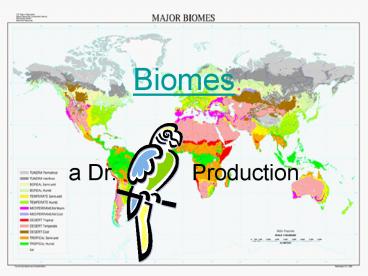Biomes - PowerPoint PPT Presentation
1 / 31
Title:
Biomes
Description:
Biomes a Dr. Production IV. Terrestrial Biomes (life zones) A. Def. - geographical areas distinguished by particular dominant flora B. Characteristics 1. – PowerPoint PPT presentation
Number of Views:44
Avg rating:3.0/5.0
Title: Biomes
1
Biomes
- a Dr. Production
2
IV. Terrestrial Biomes (life zones)
- A. Def. - geographical areas distinguished by
particular dominant flora - B. Characteristics
- 1. Not a place, but a class of plants
- 2. Determined by climate
- 3. Boundaries are indistinct
- 4. Convergent evolution common between similar
biomes - Plant Adaptations
- Brain Pop Land Biomes (dekalbcs dekalb)
3
(No Transcript)
4
(No Transcript)
5
Adaptations for Tundra Life
6
(No Transcript)
7
Adaptations for CF Life
8
(No Transcript)
9
Adaptations for DF Life
10
(No Transcript)
11
Adaptations for RF Life
12
(No Transcript)
13
(No Transcript)
14
Adaptations for Grassland Life
15
(No Transcript)
16
Adaptations for Desert Life
17
V. Marine Aquatic Biomes
- Primary ecological subdivisions of organisms
- 1. Plankton - at mercy of currents, weak or
nonswimmers (small or microscopic) - a. Phytoplankton - primary producers,
(cyanobacteria or diatoms) - b. Zooplankton - protists and small
animals (larval stages) - 2. Benthos - bottom dwellers (sessile,
walking, or burrowing) - 3. Nekton - larger, strong swimmers (top of
the food chains)
18
- B. Freshwater
- 1. Zones
- a. Littoral zone - near shoreline, richest
in life - b. Limnetic zone - open water, sparse life
- c. Profundal zone - deep. anaerobic, no
light, detritovores, mineral rich
19
- 2. Lake stratification and seasonal turnover
20
- 3. Types of lakes
- a. Oligotrophic - nutrient-poor, deep, sandy
or rocky bottom, clear - b. Eutrophic - nutrient-rich, phytoplankton
very productive, shallow, murky - Oligotrophic lake Eutrophic lake
Eutrophication
(lake aging)
21
Adaptations for Aquatic Life
22
- Marine life zones
- 1. Estuaries and salt marshes - where rivers
(freshwater) meets saltwater of ocean - - most fertile water in the world, breeding
grounds for many fish, nutrients from rivers
meets constant mixing of tides (plants)
23
- 2. Intertidal zone - between high and low tides,
rich in life forms (barnacles, clams, crabs),
tidal pools - 3. Subtidal zone - sea stars, sea urchins, worms,
crabs, flounder - 4. Neritic zone - over continental shelf (nekton
and most benthic organisms are here (food is
here) photosynthetic limit - 200 meters - 5. Pelagic zone includes neritic and open ocean
- 6. Benthic zone - deep waters, mostly predators
24
Neritic zone
- (Neritic zone)
25
- Pelagic Zone
26
Coral Reefs of the World
27
Adaptations for Coral Reef Life
28
Abyssal Zones
1. The mid-ocean ridge system with well known
deep-water hydrothermal vent (ellipses) and cold
seep (oblongs) regions. Vents 1, Mid-Atlantic
Ridge 2, East Pacific Rise 3, Galapagos Rift
4, NE Pacific 5 and 6, W Pacific back-arc
spreading centres 7, Central Indian Ridge. Cold
seeps 1, Gulf of Mexico 2, NW Africa 3,
Laurentian Fan 4, Barbados accretionary prism
5, Monterey Bay 6, Oregon subduction zone 7,
Sagami bay.
29
Geothermal Vents, 2
30
Adaptations for Abyssal Life
31
Biomes Resources
- Biome Interactive Movie
- Biomes of the World Videos
- Planet Earth Ice Worlds Oasis of Rock
- Essential Endangered Coral Reef Biomes
- Plant Adaptations































